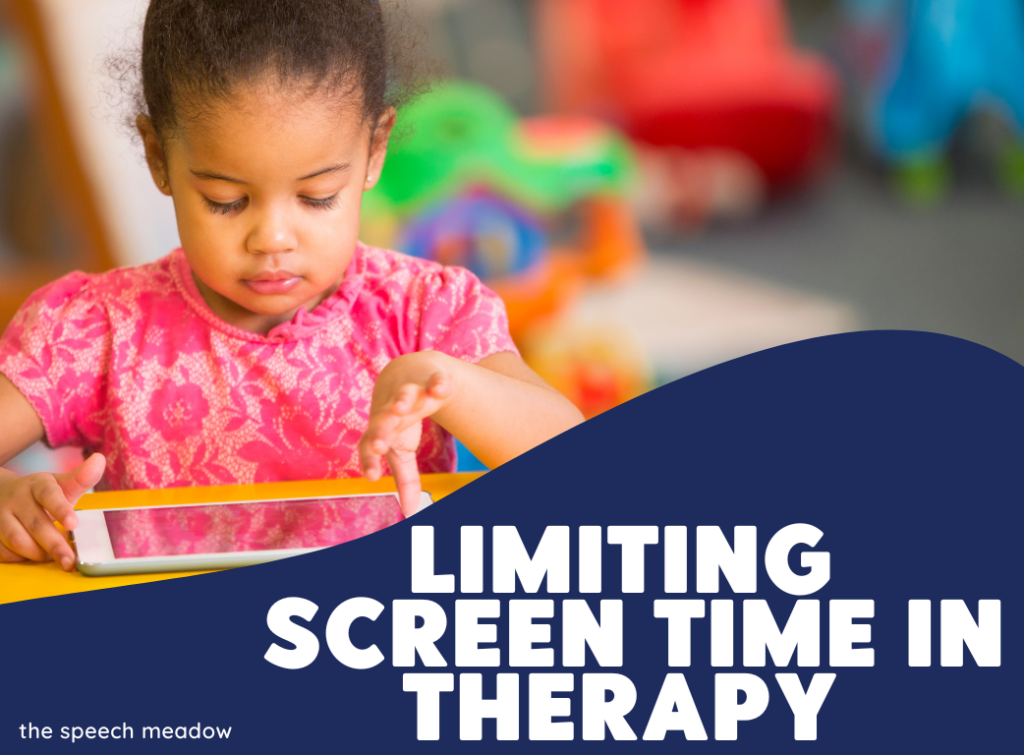Everyday there seems to be new apps or no print activities released on iTunes or Teachers Pay Teachers or Boom that work on speech and language skills. These activities can be great. They are interactive and you don’t have to do a lot of prep plus most children love to play them. They make taking data easy. When I first got my iPad a few years ago, I used it frequently in preschool therapy. As the years have gone by, I have found that I am using my iPad less and less. For the last year or so, I bring it out rarely and when I do, it is only for very special occasions. Here is why I’m limiting screen time in therapy.


I count screen time as using an iPad/tablet, smartphone, TV, Smartboard (or like products), or a computer. I don’t consider dedicated speech generating devices (SGD) as a screen because SGDs are an essential tool to help children gain their independence and communicate.
Here is why I’m limiting screen time
1. The Canadian Paediatric Society and its American counterpart have set some strict guidelines about the amount of screen time children should be exposed to. Click here for the Canadian Paediatric Society position paper on screen time. For children between the ages of 2 and 4, they recommend no more than an hour a day. Talking with parents, it is not uncommon for preschoolers to spend anywhere from three to six hours a day in front of a screen. I do not need to add to their screen time.
2. Many children I work with have weak play skills. Play skills are very important for preschoolers. It helps them learn how to interact with their world and it teaches them about how to get along with others. It helps develop a child’s imagination. There are not many games/apps on a screen where a child can pretend play and use their imagination (Toca Boca has some good apps for pretending). Many apps that I have come across are either test type activities or sequential type activities (i.e. I go through the steps and something happens at the end). These apps have their place but I believe that playing with toys/their environment is a better way to develop play skills. Check out this post on why SLP play during therapy (click here).
3. When children play with objects, they learn a variety of different problem-solving skills and are experiencing hands on learning. For example, what happens if my toys don’t all fit into the pretend fridge or what do I do if part of my fort collapses? Play can also help with generalization. When using objects means that the activity can be easily altered or the outcome will be different each time. While improving, many games have a finite set of questions/activities and they some don’t shuffle the activities. This does not help with generalization. I have worked with children (often with an Autism Spectrum diagnosis) who can demonstrate a skill on the tablet but can’t do it in any other situation with any other tools.
4. Sometimes the tablet is too engaging and it’s difficult to add the therapy piece to the activity. The children would “zone out” or try to move their bodies around so that they were the only ones engaging in the activity. It is then not an appropriate therapy tool.
5. In a classroom setting, I would have children arguing or having temper tantrums because they wanted a turn or a longer turn. As well, I would often have four or five other children hanging around watching. I was then limiting the play opportunities for more than just the student(s) who were using the tablet.
Screens have their place in therapy but for the stated reason above, I have chosen to limit the amount of games, apps, no print activities, and videos that preschoolers are exposed to in therapy.
